Microlearning
Learn about microlearning, what makes it effective, and how to implement it successfully in your organization. Discover its examples and best practices.

Microlearning is a way of teaching and training employees in ways that take little time but ultimately reach the intended goal.
In this guide, you will learn about microlearning, what makes it effective, and how to implement it successfully in your organization.
Discover:
- What is microlearning?
- Benefits of microlearning
- Challenges of microlearning
- Microlearning examples
- Principles and best practices of microlearning
What is microlearning?
Microlearning is an approach to learning new information in small chunks at a time. Typically, microlearning sessions are under ten minutes and can take as little as one minute to complete.
Microlearning theory
The whole concept of microlearning is based on the Hermann Ebbinghaus forgetting curve.
In the mid-1880s, Hermann Ebbinghaus became the first person to create a scientific approach to study and classify memory and introduce the world to concepts like the learning curve and forgetting curve.
During his studies, he tested subjects on their memory of sets of inconsequential, erroneous sounds and syllables. Throughout these trials, he began assessing the capabilities and function of memory in his subjects.
Ebbinghaus noted that memory does not stay consistent throughout trials. Memory can increase, decrease, and back again many times.
Of course, this also depends on not only the subject matter being learned but also the methods in which it is learned. These methods and studies also correspond to his studies on forgetting, and ultimately his “forgetting curve.”
This also led to the discovery of memory ‘savings.’ Memory saving refers to knowledge once held at the top of the mind, in complete (or at least relatively complete) accuracy, and the retention of the information thereafter.
He found that strictly memorized information can be recalled much more easily after learning it again, even after a significant time without using it.
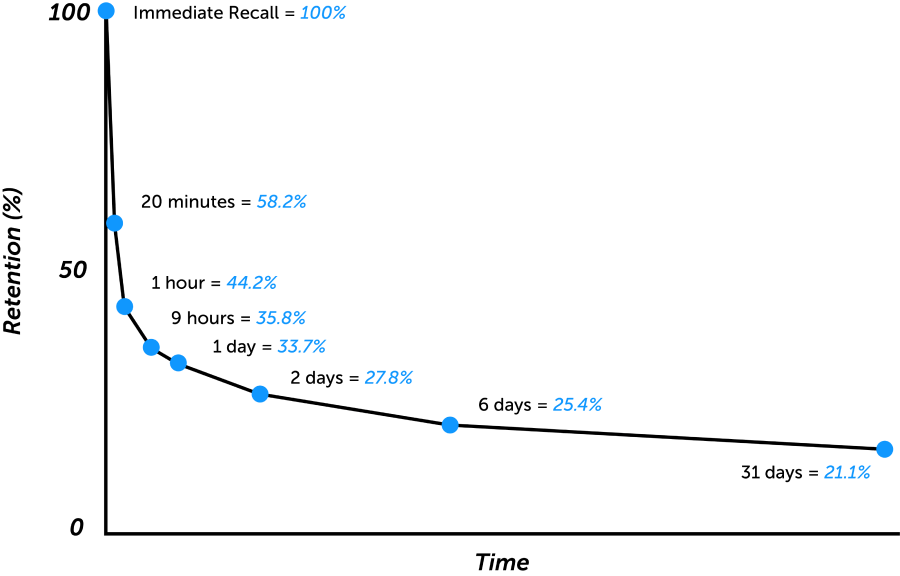
The Ebbinghaus Forgetting Curve graph
As the Ebbinghaus Forgetting Curve demonstrates, people typically lose 80% of the knowledge they learn within a month.
When people learn large amounts of information, they do retain it for a certain amount of time. However, if that information isn’t considered ‘crucial’ to the tasks at hand, the knowledge tends to degrade over time.
The microlearning concept can be used to tackle this issue. Splitting the content into small pieces and recalling different parts of it over time can help improve knowledge retention and productivity.
In Ebbinghaus’ memory retention graph, shown below, you can see that when someone first learns something, they retain all of that information. As the days pass, memory retention begins to drop. But as you perpetually review information, you retain more and more of it.
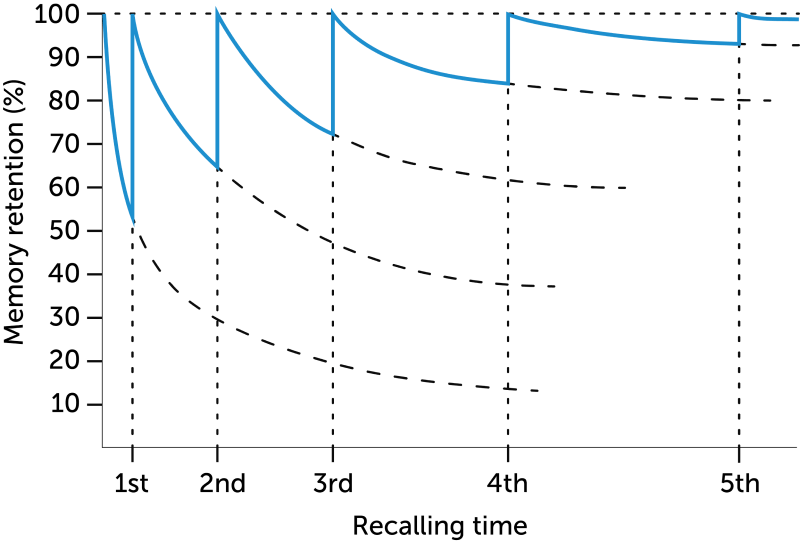
Ebbinghaus memory retention graph
Microlearning can really improve on-the-job training because employees will learn in a short period of time, and without disrupting their daily tasks. It is possible because microlearning works with the brain to prioritize information that may be more relevant to a daily workflow.

The definitive guide to microlearning
The what, why, and how-to guide to inject microlearning into your company.
DOWNLOAD GUIDEBenefits of microlearning
1. Requires less time to consume the content
The #1 reason employees say they are not engaging in workplace learning is because they don’t have the time.
The main point behind microlearning is that it’s quick. At the very most, it takes about ten minutes.
With all the tasks employees are expected to perform- the less time they have to spend in training, the better. In short, employees still learn extra skills for their jobs, but without taking the time they can’t afford to do so.
Microlearning is how you will learn parts of your job in small bits, although with reduced time investments, and additional benefits that employees can utilize on a daily basis.
2. Increases learners’ engagement
Even people with great attention spans can struggle to remain engaged in long learning sessions. However, when people know that their learning or training will take only a few moments, it’s much easier for them to sit through.
Most people are wired to engage with new information for shorter, rather than longer, periods of time. Microlearning caters to this and keeps employees engaged.
3. Improves knowledge retention
As we mentioned, knowledge is more likely to be retained when we recall it over and over again.
Microlearning facilitates self-directed lifelong learning, as short activities can be easily integrated into everyday activities.
Small learning steps, with small chunks of information, can be used for learning in between and on-demand. In this way microlearning enables individuals to stay up-to-date in today’s knowledge society. Small injections of information to review what was learned help to reinforce knowledge, and memory.
Microlearning allows constant training, with the knowledge that is retained over time.
4. Enables learning on the go (mobile learning)
Because microlearning relies on small, bite-sized training sessions, it’s easy to make it accessible for any device- not just computers.
Larger training courses can be difficult for employees to keep up with. They may need to pause in the middle of a course. That means they might lose their place, or forget previous information and have to backtrack before resuming the rest of the course.
Microlearning works in synergy with mobile learning so that you can learn on the go. Short, bite-sized lessons make it easy to fit into a busy schedule. Learn (nearly) anywhere, any time.
5. Supports self-paced learning
People all learn differently, and microlearning allows people to find a way of learning that works for them. Rather than having to conform to a rigid, structured course of learning, they can find a flexible solution in microlearning. Employees can learn at their own pace, whether it’s a subject they excel in or one they need to take more time to master.
If an employee needs to review a certain piece of information, they don’t delay the rest of the learning course. That certain piece of information is the majority or the entirety of the short training course.
6. Enables personalized learning
Traditional training and learning courses can be difficult for employees to get through because they often contain information that isn’t specifically relevant to the employee’s role.
Microlearning allows you to construct your learning paths with short, informative pieces of learning, which don’t incorporate extraneous information.
Also, it makes it easier to rotate and recommend different pieces for different roles – enabling flexible and personalized learning paths.
Each microlearning course has a targeted focus on one specific item. This also ensures that employees don’t waste time trying to sift through a large course to find the one or two sections that they actually need to learn.
Challenges of microlearning
1. It takes work and resources to maintain
One of the biggest myths about microlearning is that it is easy to create and maintain learning materials. Unfortunately, it isn’t true.
On the employer’s side, microlearning programs can take time, resources, and plenty of effort to maintain.
You may already have plenty of courses and training materials at your disposal. And just simply splitting them into smaller segments isn’t always effective.
You need to take time to plan out your microlearning modules and make sure they’re relevant for the employees using them.
This can also become complicated because you need to ensure that each session makes sense on its own, and can fit into a greater, sequential part of learning (to make sense with courses that come before and after it).
Another point to remember is that you will need to periodically update your microlearning content as technology and business procedures change over time (and sometimes very rapidly).
2. Scaling personalized content
Personalizing millions of pieces of content so that they are relevant to every individual person can be extremely tedious or even impossible.
Because microlearning courses are very short pieces, it means that a full, traditional course could be split into many dozens of microlearning courses.
For the entirety of a company’s training materials, that could ultimately result in thousands of different modules or even much more.
Going through all this information, personalizing it, and directing it to the right individuals can be extremely difficult.
Instructional designers need to figure out how to organize that information, and direct it to the individuals it’s relevant to.

The definitive guide to microlearning
The what, why, and how-to guide to inject microlearning into your company.
DOWNLOAD GUIDE3. Accessibility problem
If just splitting the large course into short microlearning chunks isn’t an easy task, imagine how difficult it is to make it accessible for people with disabilities.
It’s still a large task for instructional designers and requires specific knowledge and technologies.
Designers need to make sure that the courses are formatted and optimized according to accessibility standards and best practices.
4. Lack of time to invest
Ultimately, some employees are just in high demand and incredibly short on time, no matter what.
These employees may still have time to research small issues that need to be resolved on their own.
However, it can also be quite a struggle for them to find time throughout their day (no matter how accessible the courses are) to participate in mandated microlearning courses.
If employees struggle to find time to follow a microlearning course, it’s also fairly likely that they can’t find the extra time to independently research even small tasks that would make their jobs easier.
Microlearning examples
1. Microcopy
Short, targeted, highly contextual messages or hints, to help users learn.
Examples:
- Error messages
- Contact form explainers
- eCommerce hints
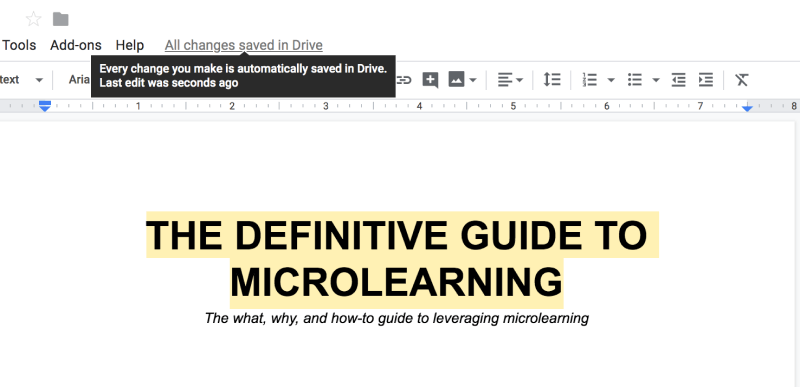
Tooltip from Google Drive explaining that every revision on the document is saved
2. Microlearning videos
Short, focused videos that are designed to meet a specific learning outcome. Microlearning videos can be designed to be: A standalone nugget that offers a specific learning takeaway. A part of a longer learning path.
Examples:
- Explainer videos
- Brief & interactive videos
- Micro-lectures
- Whiteboard animations
- Kinetic text-based animations
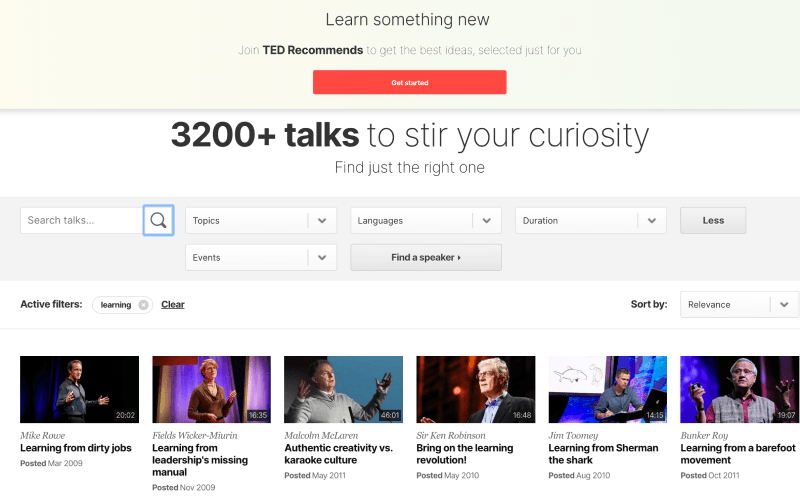
Ted Talks are micro-lectures that feature an expert speaking on a specific topic, limited to a maximum of 18 minutes
3. Microlearning apps or mobile apps
Apps that give you micro-lessons, on-the-go
Examples:
- Youtube
- Headspace
- Lasting
- Word of the day
- TED
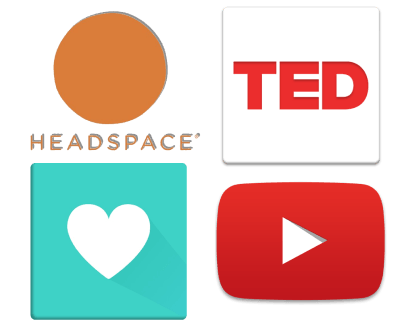
4. Micro-challenges and games
Learning that is scored at the end, that can include an award, benefits, badges, notoriety, or other incentives for taking part or achieving a high score.
Examples:
- Multiple question quizzes
- Polls, flashcards
- Question & responses
- Simulations
- Learner recordings to answer questions
5. Infographics
Infographics (and often iconic, focusing on key points and numerical values) are graphic visual representations of information, data, or knowledge.
Examples:
- Statistical infographics
- Informational infographics
- Timeline infographics
- Process infographics
- Geographic infographics
- Comparison infographics
- Hierarchical infographics
- List infographics
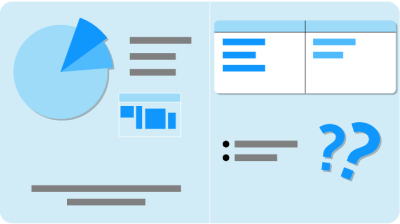
Example of infographic used for microlearning.
6. Social Media
Social media can be used as a micro-blogging exercise, and you can learn nuggets of information from the stream of content you subscribe to. Social media can be used as an activity feed of online communities of practice.
Examples:
140 character snippets of news on social media
- Wall Street Journal
Principles and best practices of microlearning
1. Define if it’s a good fit
Microlearning can be a great tool, but it’s not necessarily suited to every subject matter.
Some tasks are very complex, and can’t be squeezed into a segment under ten minutes.
Likewise, there are certain tasks that are nearly impossible to teach from an e-course, textbook, or slideshow. These tasks require in-person or on-the-job training, which is infeasible to complete in such short, condensed segments.
However, it can still be a very good complimentary training approach.
2. Rework or reuse existing courses
You can ease the workload of creating an entirely new microlearning curriculum if you already have training courses and materials in place.
Some parts of your existing training courses can be split into smaller segments ‘as-is’ and used, as long as they make sense. Or, other parts can be reworked to fit a microlearning structure.
3. Use gamification mechanics
Using gamification mechanics and techniques can turn your microlearning courses into a ‘game’ per-se.
It gives your employees the same feelings of achievement and satisfaction in completing a goal that they might receive when they complete a level in a game.
This can mean that you award digital badges after they complete a set of microlearning courses on a certain subject, or allow for displays of points and status through the company.
While these ‘rewards’ are intangible, they do give employees a boost for their accomplishments, and give employees incentive to continue their microlearning. Or you can choose to award monetary bonuses, extra time off, or certificates (such as learner of the month) when employees complete courses.
4. Use short videos and other interactive assets
One of the best things about microlearning is that it boosts engagement. However, you can enhance your microlearning program even further by including attention grabbing elements like videos and quizzes.
The great thing about videos is that it brings our visual and auditory senses together, which of course, grabs greater attention from viewers.
Keep the videos short, as with the rest of your microlearning content. The shorter the video is, the more engaging and memorable it is. Just make sure you include all the relevant information in an appropriate time frame.
5. Don’t forget to add recurring content
Do you remember the main concept from the Ebbinghaus studies?
Recalling the studied materials over time will help people retain them for a longer period of time.
At the end of a series of microlearning modules, or at the end of a shorter microlearning segment, include tools for employees to review what they’ve learned.
This can be a quiz at the end of a series of segments or a slide with bullet points of the main takeaways from the course. Or, you can choose to include references to a previous learning module in those that come afterward. Either way, it’s a good idea to refresh employees’ memories.
6. Provide access anytime, on any device
Microlearning is so attractive to employees because it doesn’t require them to be chained to their desktop at work to complete it.
As such, it’s essential that you create microlearning materials that are available on any device, and especially on smartphones and tablets.
Make sure there are no restrictions that prevent employees from being able to access these resources whenever they get the time.
If the only way people can access microlearning courses is on their work desktop computer, it doesn’t carry the same benefits.
7. Encourage social and collaborative learning
Social learning and collaborative learning can be some of your biggest allies when you implement a microlearning program in your organization (see the links to the guides for further information).
Both of these methods of learning encourage people to learn and grow their skills from people around them. While social learning focuses more highly on imitation (seeing positive behaviors in others and attempting to replicate them), collaborative learning focuses more on brainstorming with peers, seeing their perspectives, and learning as a result.
Allowing for discussion and even comments on microlearning modules can engage employees, motivate them more, and even alert you to knowledge gaps that need to be filled in.

The definitive guide to microlearning
The what, why, and how-to guide to inject microlearning into your company.
DOWNLOAD GUIDE



